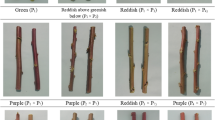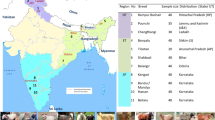Summary
In the absence of differential selection the phenotypic distributions of the pure-breeding lines extractable from an F1 hybrid are identical irrespective of whether they are derived by dihaploidy or single seed descent. This identity is not affected by the kinds of gene action, genie interaction and genotype × environment interaction contributing to the phenotypic differences. Linkage disequilibrium alone produces a difference between them and this can be minimised by delaying the extraction of the dihaploids until the F2 or F3 generations. The genetic components of the means, variances, skewnesses and kurtoses of these phenotypic distributions can be estimated from the early generations of a cross.
Similar content being viewed by others
Article PDF
References
Jayasekara, N E M, and Jinks, J L. 1976. Effect of gene dispersion on estimates of components of generation means and variances. Heredity, 36, 31–40.
Jinks, J L. 1978. Unambiguous test for linkage of genes displaying non-allelic interactions for a metrical trait. Heredity, 40, 171–173.
Jinks, J L. 1981. The genetic framework of plant breeding. Trans Roy Soc (In press).
Jinks, J L, and Perkins, J M. 1970. A general method for the detection of additive, dominance and epistatic components of variation. III. F2 and backcross populations. Heredity, 25, 419–429.
Jinks, J L, and Pooni, H S. 1976. Predicting the properties of recombinant inbred lines derived by single seed descent. Heredity, 36, 253–266.
Jinks, J L, and Pooni, H S. 1981. Comparative results of selection in the early and late stages of an inbreeding programme. Heredity, 46, 1–7.
Jinks, J L, Jayasekara, J E M, and Boughey, H. 1977. Joint selection for both extremes of mean performance and environmental sensitivity to a macroenvironmental variable. II. Single seed descent. Heredity, 39, 345–355.
Kearsey, M J, and Jinks, J L. 1968. A general method of detecting additive, dominance and epistatic variation for metrical traits. I. Theory. Heredity, 23, 403–409.
Mather, K, and Jinks, J L. 1971. Biometrical Genetics (2nd Edn.). Chapman and Hall, London.
Perkins, J M, and Jinks, J L. 1970. Detection and estimation of genotype-environmental, linkage and epistatic components of variation for a metrical trait. Heredity, 25, 157–177.
Pooni, H S, and Jinks, J L. 1979. Sources and biases of the predictors of the properties of recombinant inbreds produced by single seed descent. Heredity, 42, 41–48.
Pooni, H S, Jinks, J L, and Cornish, M A. 1977. The causes and consequences of non-normality in predicting the properties of recombinant inbred lines. Heredity, 38, 329–338.
Author information
Authors and Affiliations
Rights and permissions
About this article
Cite this article
Jinks, J., Pooni, H. Properties of pure-breeding lines produced by dihaploidy, single seed descent and pedigree breeding. Heredity 46, 391–395 (1981). https://doi.org/10.1038/hdy.1981.47
Received:
Issue date:
DOI: https://doi.org/10.1038/hdy.1981.47
This article is cited by
-
Comparison of single seed descent and anther culture-derived lines of three single crosses of rice
Theoretical and Applied Genetics (1993)
-
The effects of major genes on quantitatively varying characters in barley. 4. The GPert and denso loci and quality characters
Heredity (1991)
-
Prediction of progeny variation in oat from parental genetic relationships
Theoretical and Applied Genetics (1991)
-
A comparison of traditional and haploid-derived breeding populations of oilseed rape (Brassica napus L.) for fatty acid composition of the seed oil
Euphytica (1990)
-
A comparison of anther culture derived material with single seed descent lines in Brussels sprouts (Brassica oleracea var. gemmifera)
Heredity (1989)



